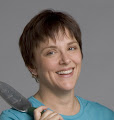
Ellen Zachos forages for food like Ginkgo nuts: I forage for natural materials to decorate my home. This time of year some of my favorite finds are baseball-sized chartreuse ‘brains’, the fruit of the Osage orange tree (Maclura pomifera). They fall to the ground, sometimes cracking, exposing the milky flesh and seeds to squirrels. But often they remain whole an
 d are perfect for me.
d are perfect for me.I have no Osage orange trees in my neighborhood but my friend Lois scouts the crop in Riverside Park where she walks daily, and favors me with regular reports. When the time is ripe I go early in the morning before the efficient park employees have raked up the debris, and look around for whole, unblemished fruit hiding in the grass, then schlep them home. After rinsing and drying I store in the fridge until I get enough for a nice display.
Creating the Design: How To
Start with a clear glass or wire bowl and start piling up the Osage oranges, biggest on the bottom and any black spots hiding toward the inside. Work up toward a pyramid shape. Intersperse with other foraged seedpods, cones, or nuts: here sweet gum balls, horse chestnuts. Locust pods rest on the table. If you have extra fruit, place them on shot glasses around the central bowl.
You can save the oranges in a cool place to mix with other materials for Thanksgiving or Christmas displays. I often slice the fruit and dehydrate in the oven to make beautiful decorations for a holiday bird feeder tree, but more about that in December.
The Search
Not typically used as street trees in New York City since a falling fruit might literally ‘brain’ you, Osage orange trees find a home in many of the larger city parks. I’m not going to pinpoint my favorite trees, because I’m selfish. But search in parks near you from mid October through late November and ask a park employee. Even if the worker doesn’t know the tree by name, there’s no missing that messy fruit.

More About the Tree
It’s an American native, sometimes called hedge apple and can reach 60’ tall. The bark has a dark orangey tinge and I find that easier to spot than identifying the leaves when I’m on the prowl. The wood is tough, not prone to rot and excellent for making bows. They used to be planted in hedgerows on farms in the mid west. The tree bible by Michael A. Dirr (Dirr’s Hardy Trees and Shrubs) says that the tree withstands “wetness, dryness, wind, extreme heat and will grow where few other plants will”, just don’t think of it for your garden.







2 comments:
I enjoyed your blog very much indeed. Please tell me more about the succulents in the hay bale. How did you do it? Did you keep the bale intact and stick the plants in it?
Thanks,
Betty V
Hi Betty,I'm new at this hay bale thing too. I poked and prodded to make small pockets, added some potting soil and planted small succulents that I could steal from other of my pots. Hens & chicks were perfect. Kept watered as needed and they were still looking great until some masons came to find the leak in the brick work on that side of the building and threw those bales around. The masons proved the theory that the bales will ultimately disintegrate and become compost. Wait 'til next year!
Comment refers to the first post on this blog, 'My Stars'
Post a Comment